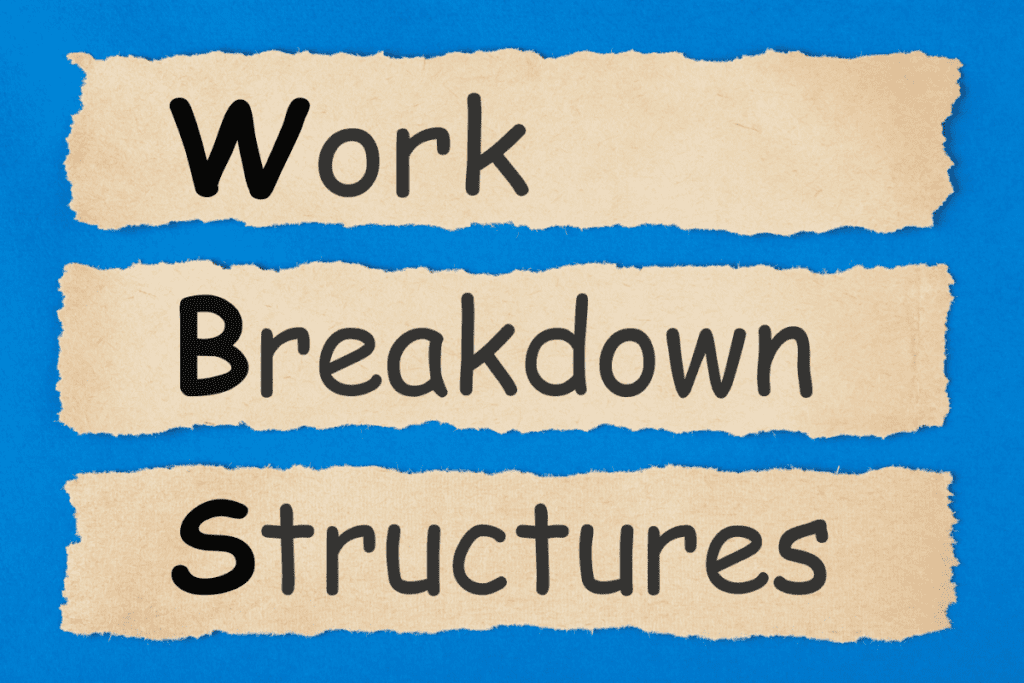The WBS: What is a Work Breakdown Structure in Project Management?
Introduction
Feeling overwhelmed by the complex task of managing a project? You’re not alone. Understanding what is a Work Breakdown Structure in Project Manager is foundational to managing an effective project schedule. A Work Breakdown Structure (WBS), a methodical approach to breaking down work into manageable chunks, can be your game-changer.
This article will guide you through everything about WBS, from understanding its importance in Project Management to creating one efficiently. Stay tuned ─ it’s time to simplify your project management journey!
Key Takeaways
- A Work Breakdown Structure (WBS) is a visual and hierarchical breakdown of tasks in a project, providing clarity and enabling efficient planning.
- The WBS increases clarity around roles and responsibilities, ensures tasks are completed properly and on time, and enables activity tracking.
- There are different types of WBS, such as deliverable-based and phase-based, that project managers can use to organize their projects.
- Elements of a WBS include project deliverables, phases, work packages, control accounts, and a WBS dictionary.
- Steps to create a WBS include defining the project scope, identifying project phases & control accounts,
What Does WBS Stand for in Project Management?
A WBS, or Work Breakdown Structure, is a visual and hierarchical breakdown of what needs to be done in a project. The WBS serves as an effective roadmap, charting out all the tasks required for successful completion of the project scope.
The WBS is a fundamental tool integral to successful project management planning and execution.
This deliverable-oriented deconstruction provides clarity and enables efficient planning, paving the way for streamlined execution.
The structure of the WBS is designed strategically. I breaks down large projects into manageable chunks or work packages, each with their own set goals and deliverables. By laying out tasks visually on Gantt charts or Kanban boards, the process becomes clearer. Using project management software tools further simplifies this process. These work packages are then easier to understand. Assigned task owners can complete them successfully within stipulated deadlines. As a result, common problems like cost overrun are avoided. It also prevents missed schedule milestones.
According to the Project Management Body of Knowledge (PMBOK®) and the Practice Standard for Work Breakdown Structures from the Project Management Institute (PMI), the work breakdown structure (W BS) is a deliverable-oriented hierarchical decomposition of the work to be executed by the project team. It is a tool that can be used to effectively decompose the project scope, improve estimating, better control project execution, and more accurately verify project completion.
The WBS becomes instrumental in controlling various aspects important for success, including budgeting, risk management, resource allocation, and more while ensuring precise coordination among teams involved in different parts of the project life cycle.
What is the Purpose of a Work Breakdown Structure in Project Management?
The Work Breakdown Structure (WBS) is highly important in project management as it increases clarity around roles and responsibilities, ensures tasks are completed properly and on time, and enables activity tracking.
Increases clarity around roles and responsibilities
A well-crafted Work Breakdown Structure (WBS) plays a crucial role in defining roles and responsibilities within a project. It provides team members with a clear picture of their respective tasks, making it easier for them to understand their individual contributions towards achieving the project goals.
The visual representation of tasks and deliverables that WBS offers helps eliminate confusion or overlapping duties, thus fostering an environment where each team member’s accountability is enhanced.
This clarity ensures everyone on the team knows what they should be doing at any given time, leading to improved productivity and successful total project execution.
Ensures tasks are completed properly and on time
A well-constructed Work Breakdown Structure (WBS) plays a pivotal role in ensuring tasks are executed accurately and punctually. By dissecting complex projects into manageable phases, sub-projects, tasks, deliverables, and work packages, it provides clarity about what needs to be done by whom and when.
This hierarchical decomposition of the project scope helps teams avoid common issues like missed deadlines – a primary cause of cost overrun. With the aid of advanced project management software and Gantt charts incorporating WBS levels along with task hierarchies, this approach allows managers to monitor progress against timelines meticulously.
Each component of the structure has a control account responsible for tracking budgeted costs versus actual expenditures – putting them at the forefront of managing time efficiently. Thus, resource allocation becomes more precise with a properly defined WBS.
Enables activity tracking
The Work Breakdown Structure (WBS) is a crucial tool in project management as it enables activity tracking. With a well-constructed WBS, project managers can easily monitor and track the progress of tasks and activities throughout the project lifecycle.
By breaking down the project scope into smaller components, such as phases, sub-projects, tasks, deliverables, and work packages, the WBS provides a clear roadmap for tracking each activity’s completion.
This not only helps ensure that tasks are completed on time but also allows project managers to identify any bottlenecks or delays early on and take appropriate actions to keep the project on track.
What are Some Different Types of Work Breakdown Structures (WBS)?
There are different types of Work Breakdown Structures (WBS) that project managers can use to organize their projects and tasks. Interested in learning more about the various types? Read on!
Deliverable-Based Work Breakdown Structure
A deliverable-based work breakdown structure (WBS) is a method of breaking down a project into manageable components. It focuses on dividing the project scope into major areas, control accounts, project deliverables, and work packages.
This type of WBS provides a clear and organized roadmap for completing the project by identifying specific deliverables that need to be achieved. Each deliverable is then broken down further into work packages, which are individual tasks or activities that contribute to the completion of the deliverables.
By using a deliverable-based WBS, project managers can easily plan and allocate resources, track progress, and ensure that all necessary tasks are completed on time and within budget.
Phase-Based Work Breakdown Structure
A phase-based work breakdown structure (WBS) is a type of WBS that organizes project tasks based on the different phases of a project. This type of WBS displays the final deliverable on top and shows the project phases below, such as initiation, planning, execution, control, and closeout.
By breaking down projects into phases, it helps project managers to better understand the sequence of tasks required for each phase and ensure that all necessary steps are completed in a timely manner.
The phase-based WBS provides a clear roadmap for project teams. This is done by outlining the specific activities needed during each phase and allows them to focus on one set of tasks at a time. It also facilitates effective communication among team members as they can easily identify which phase they are currently working on and what needs to be accomplished before moving forward.
What are the Top 5 WBS Elements?
A Work Breakdown Structure (WBS) is made up of several key elements that help organize and define a project.
These elements include:
1. Project deliverables: The desired outcomes or results of the project, which are broken down into smaller components.
2. Project phases: The distinct stages or steps required to complete the project, each with its own set of tasks and deliverables.
3. Work packages: The smallest units of work within the WBS, often assigned to specific individuals or teams for completion.
4. Control accounts: Higher-level categories that group related work packages together for easier management and tracking.
5. WBS dictionary: A document that provides detailed descriptions and specifications for each element in the WBS, including their relationships and dependencies.
What are the Key Steps to Create a Work Breakdown Structure?
To create a Work Breakdown Structure (WBS), follow these steps: define the project scope, goals, and objectives; identify project phases & control accounts; list your project deliverables; set WBS levels; create work packages; and choose task owners.
Define the Project Scope, Goals, and Objectives
To create an effective Work Breakdown Structure (WBS), it’s crucial to start by defining the project scope, goals, and objectives. The project scope outlines the boundaries and deliverables of the project, helping to determine what work is included and what is not.
By clearly defining the scope, you can avoid unnecessary scope creep and ensure that everyone involved understands the project’s boundaries.
Next, identify the specific goals and objectives of the project. Goals are broad statements that describe what you aim to achieve overall, while objectives are more specific and measurable targets that contribute to reaching those goals.
Clearly defined goals and objectives provide a clear direction for your WBS by ensuring that all tasks align with these overarching targets.
Identify Project Phases & Control Accounts
To create an effective Work Breakdown Structure (WBS), it is crucial to identify the project phases and control accounts. Project phases are the distinct stages that a project goes through from initiation to completion, while control accounts are specific points of control within each phase.
By clearly defining and organizing these phases and accounts, project managers can ensure better organization, tracking, and management of tasks. This helps in breaking down the overall project into manageable chunks, allowing for better resource allocation and monitoring progress throughout the project lifecycle.
List Your Project Deliverables
To create a work breakdown structure (WBS), it is crucial to start by listing your project deliverables. These are the tangible or intangible outcomes of your project that need to be produced or achieved.
By identifying and listing these deliverables, you can get a clear overview of what needs to be accomplished throughout the project. This step helps in breaking down the project into smaller, manageable tasks and ensures that nothing important is overlooked.
With a comprehensive list of deliverables, you can set clear objectives for each phase and allocate resources accordingly, leading to better planning and successful project execution.
Set WBS Levels
Setting WBS levels is a crucial step in creating a Work Breakdown Structure (WBS) for project management. WBS levels determine the level of detail and granularity at which tasks are broken down within the structure.
By establishing these levels, project managers can ensure that the WBS provides clear visibility into the various elements of the project, from high-level phases to specific work packages. This allows for better organization, delegation of tasks, and tracking progress throughout the project lifecycle.
With well-defined WBS levels, project managers can effectively manage their projects by breaking them down into manageable and actionable components.
Create Work Packages
Creating work packages is a crucial step in developing a work breakdown structure (WBS). Work packages are the smallest units of work within a project that can be assigned to individuals or teams.
They represent specific tasks or activities required to complete each deliverable identified in the WBS.
Work packages break down the project into manageable and actionable components, making it easier for project managers to allocate resources, estimate effort, and schedule tasks. By clearly defining the scope of each work package, project managers can ensure that all necessary activities are accounted for and assigned appropriately.
Furthermore, work packages serve as building blocks for tracking progress and monitoring the overall performance of a project. Assigning ownership to each work package allows team members to take responsibility for their designated tasks and ensures accountability throughout the project lifecycle.
Choose Task Owners
When creating a Work Breakdown Structure (WBS), one important step is to choose task owners. Task owners are individuals or teams responsible for completing specific tasks within the project.
It is crucial to assign task ownership as it increases accountability and ensures that each task has someone responsible for its completion. By assigning task owners, project managers can effectively delegate work, track progress, and address any bottlenecks or issues that may arise during the project.
This helps in achieving better coordination and collaboration among team members, ultimately leading to successful project execution.
Transition from WBS to a Critical Path Schedule
The transition from a work breakdown structure (WBS) to a critical path schedule is an essential step in project management. It enables project managers to determine the project’s timeline and identify any potential bottlenecks or delays.
Here are some key points about this transition:.
– The WBS serves as the foundation for creating the critical path schedule.
– The WBS helps identify all the activities required to complete a project and organizes them into manageable chunks of work.
– The critical path schedule focuses on sequencing the core project activities and determines the critical activities that may impact the overall project timeline.
– Developing both the WBS and critical path schedule concurrently ensures a comprehensive project plan.
– The transition involves using the WBS as a foundation and identifying dependencies and relationships between tasks.
– Analyzing these dependencies helps determine which tasks need to be completed before others can begin, optimizing workflow efficiency.
– The critical path schedule allows for resource allocation, workload balancing, and identification of potential risks or conflicts that could affect timelines.
– Coordinating with team members, stakeholders, and subject matter experts during this transition is crucial for successful execution.
How to Get Started with an Effective Work Breakdown Structure Template Example?
A Work Breakdown Structure (WBS) example provides a practical illustration of how this project management tool is applied in real-world scenarios. Working with the team, you break out the phases to 1) understand what is involved and then 2) document the Tasks and Subtasks. This is the foundation for your project plan.
Understanding Work Breakdown Structure with an E-commerce Website Example
To better grasp the concept of a Work Breakdown Structure (WBS), let’s delve into the process of launching a new e-commerce website:
Planning and Research:
Before diving into the design, it’s crucial to understand the market. This involves identifying the target audience, analyzing competitors, and setting clear objectives for the website.
Design and Development:
Once the groundwork is laid, the next step involves creating a visual blueprint or wireframe. This is followed by the actual development, where the website’s functionalities come to life.
Content Creation:
An e-commerce site is incomplete without its products. This phase involves listing products with clear descriptions and high-quality images. Additionally, creating blog content can drive more traffic to the site.
Testing and Quality Assurance:
Before the official launch, it’s essential to test the website. This ensures a smooth user experience and helps in identifying any glitches or bugs that need fixing.
Launch and Promotion:
With everything in place, the website is ready to go live. But launching is just the beginning. Effective marketing campaigns, both on social media and through email, can drive traffic and sales.
Post-Launch Activities:
After the website is live, it’s essential to monitor its performance, address user feedback, and ensure continuous updates and maintenance. This phase ensures the website remains relevant, functional, and user-friendly in the long run.
This example showcases how a WBS breaks down a complex project into manageable tasks. This includes sub-tasks, ensuring a systematic and organized approach to completion.
WBS Level Development
Diving deeper into the project’s intricacies, the WBS Levels Development serves as the backbone, meticulously breaking down each phase into actionable tasks and sub-tasks.
WBS Levels:
- Phase 1: Planning and Research
- Task 1.1: Market Research and Analysis
- Sub-task 1.1.1: Identify target audience
- Sub-task 1.1.2: Analyze competitors
- Task 1.2: Define Website Objectives and Goals
- Task 1.1: Market Research and Analysis
- Phase 2: Design and Development
- Task 2.1: Website Design
- Sub-task 2.1.1: Create wireframes
- Sub-task 2.1.2: Design user interface
- Task 2.2: Website Development
- Sub-task 2.2.1: Set up hosting and domain
- Sub-task 2.2.2: Develop website functionalities
- Task 2.1: Website Design
- Phase 3: Content Creation
- Task 3.1: Product Listings
- Sub-task 3.1.1: Write product descriptions
- Sub-task 3.1.2: Photograph products
- Task 3.2: Develop Blog Content
- Task 3.1: Product Listings
- Phase 4: Testing and Quality Assurance
- Task 4.1: User Testing
- Task 4.2: Bug Fixes and Adjustments
- Phase 5: Launch and Promotion
- Task 5.1: Official Website Launch
- Task 5.2: Marketing and Promotion
- Sub-task 5.2.1: Social media campaigns
- Sub-task 5.2.2: Email marketing campaigns
- Phase 6: Post-Launch Activities
- Task 6.1: Monitor Website Traffic
- Task 6.2: Address User Feedback
- Task 6.3: Continuous Website Updates and Maintenance
When to Use a WBS in Project Management?
– To ensure a clear understanding of project scope and deliverables
– When breaking down complex projects into manageable tasks
– For effective resource allocation and workload balance
– To track and monitor project progress and performance
– When managing multiple phases or subprojects within a single project
– To minimize the risk of scope creep, missed deadlines, and budget overruns
– For accurate estimation of project timelines and costs
– When collaborating with cross-functional teams or external stakeholders on a project
– For better communication among team members regarding their roles and responsibilities
– To create a solid foundation for project planning, scheduling, and execution.
Defining the Scope of Work, Statement of Work, and Work Order
Defining the scope of work, statement of work, and work order is crucial in project management. These three components help establish clear expectations and guidelines for project execution. Here’s what you need to know:
- The scope of work outlines the boundaries and objectives of a project, including what will be delivered and what will not be included.
- The statement of work (SOW) provides detailed information about the project, including deliverables, timeline, resources required, and any specific requirements or constraints.
- A work order is a document that authorizes the start of a specific task or activity within a project.
Best Practices for Work Breakdown Structure in Project Management
Take time to understand your inputs and outputs, gather feedback from subject matter experts, get buy-in from stakeholders, and maintain a high-level view of the project.
Take Time to Understand your Inputs and Outputs
Understanding the inputs and outputs of a project is crucial when creating a Work Breakdown Structure (WBS). By taking the time to thoroughly comprehend what goes into your project and what comes out of it, you can ensure that every task and deliverable is properly accounted.
This understanding allows you to accurately break down the project scope, identify dependencies, allocate resources effectively, and plan for potential risks. Additionally, by being fully aware of your inputs and outputs. You can better manage expectations, mitigate scope creep, avoid cost overruns, and meet project deadlines successfully.
So don’t rush through this step; invest the time needed to grasp all aspects of your project before proceeding with creating a comprehensive WBS.
Take Advantage of Subject Matter Experts
Subject Matter Experts (SMEs) are individuals with specialized knowledge and expertise in a particular field or industry. When creating a Work Breakdown Structure (WBS), it’s crucial to involve SMEs to ensure the accuracy and completeness of the project plan.
By tapping into their knowledge, experience, and insights, you can gain valuable input on task definitions, dependencies, resource requirements, and potential risks. This collaboration with SMEs helps enhance the quality of your WBS and ultimately leads to better project outcomes.
Gather Feedback
Gathering feedback is a crucial step in creating a solid work breakdown structure (WBS). By seeking input and insights from your team members, stakeholders, and subject matter experts, you can ensure that the WBS accurately reflects the project’s scope and requirements.
Feedback helps identify any gaps or areas that need further clarification, allowing for adjustments to be made before proceeding with the project. This collaborative approach leads to better decision-making and fosters a sense of ownership among team members.
So don’t hesitate to gather feedback throughout the WBS creation process – it will lead to a more accurate and effective plan.
Get Buy-in
To ensure the success of your project and gain support from stakeholders, it’s crucial to get buy-in early on. By involving key decision-makers and obtaining their agreement and support for the project objectives, you can minimize resistance and increase the chances of successful implementation.
Getting buy-in involves clearly communicating the benefits and value of the project to stakeholders. Confirmed buy-in mitigates concerns or objections they may have, and actively involving them in the planning process.
By doing so, you create a sense of ownership among stakeholders, fostering collaboration and commitment to achieving project goals. With their buy-in secured, you can move forward with confidence knowing that everyone is aligned towards a common vision of success.
See the Forest for the Trees
It’s easy to get caught up in the details when managing a project, but it’s important to see the big picture as well. This is where the “see the forest for the trees” concept comes into play.
The work breakdown structure (WBS) helps with this by providing a visual representation of all the tasks and deliverables involved in a project. By breaking down the project scope into phases, sub-projects, tasks, deliverables, and work packages, you can easily navigate through complex projects and ensure that everything is on track.
With a well-constructed WBS, you can avoid common project management issues. Some issues are missed deadlines or scope creep while keeping your eye on the ultimate project goals. So remember to step back and look at how each task fits into the larger project to stay focused on success.
FAQs
1. What is a work breakdown structure (WBS) in project management?
A work breakdown structure (WBS) is a hierarchical framework that breaks down the scope of a project into smaller, more manageable components called work packages. It provides a visual representation of the project’s deliverables and activities, helping to organize and track progress.
2. What is the purpose of work breakdown structures in project management?
A work breakdown structure is important because it helps define the scope of the project. It’s purpose is to identify all the necessary tasks and subtasks, allocate resources effectively, estimate costs and timelines accurately, facilitate communication among team members, and monitor progress against planned objectives.
3. How do you make a work breakdown structure?
To make a work breakdown structure, start by identifying the major deliverables or outcomes of your project. Then break down each deliverable into smaller tasks or sub-deliverables until you reach manageable levels of complexity. Assign unique identifiers to each component for easy reference and use appropriate tools like diagrams or software to present the WBS visually.
4. Can an work breakdown structure change during the course of a project?
Yes. It is common for a work breakdown structure to evolve as new information becomes available or as changes occur within the project. Adjustments may be made to accommodate unforeseen circumstances, shifting priorities, additional requirements, or reevaluation of resource allocations. Regular reviews and updates are essential for maintaining an accurate representation of the project’s scope throughout its lifecycle.
5. How does a WBS help clarify roles and responsibilities?
A WBS breaks down the work needed to complete the project into specific tasks or work packages. Each work package can be assigned to specific team members, clarifying their roles and responsibilities. This ensures that every part of the project work is accounted for and that there’s a clear understanding of who is responsible for each task.
Conclusion
In conclusion, a Work Breakdown Structure (WBS) is a vital tool in project management. It allows for effective planning and execution of projects. By breaking down the project scope into manageable tasks and deliverables, the WBS helps ensure clarity around roles and responsibilities, tracks activities, and enables efficient task completion.
With the use of project management software, creating and managing a WBS becomes even more seamless and efficient. So start incorporating a WBS into your project management process today to achieve better outcomes and success in your projects.
If you liked this article, remember to subscribe to MiamiCloud.com. Connect. Learn. Innovate.









